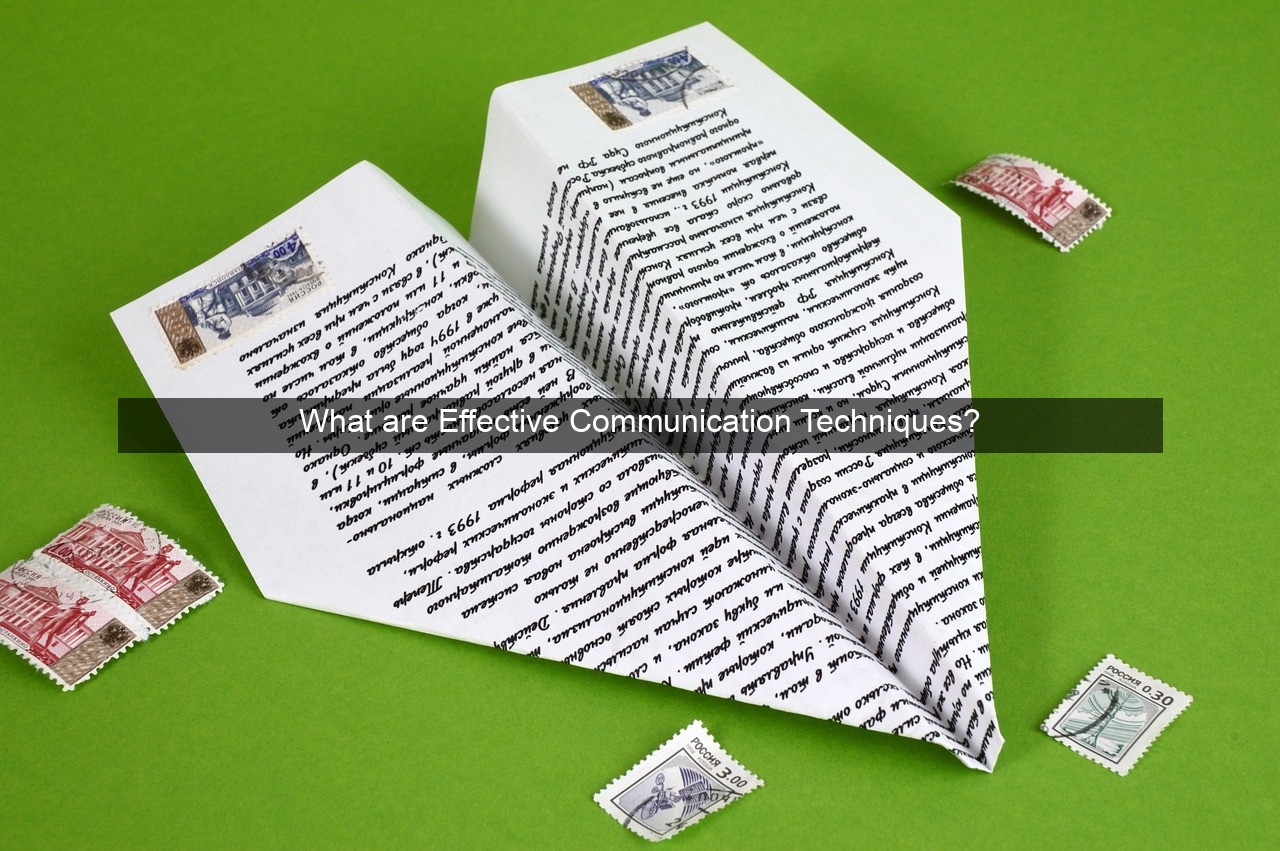What are Effective Communication Techniques?

- What are Effective Communication Techniques?
- Verbal Communication: The Power of Words
- Clarity and Conciseness
- Tone and Inflection
- Active Listening
- Nonverbal Communication: Beyond Words
- Body Language
- Facial Expressions
- Personal Space
- Written Communication: Crafting Compelling Messages
- Structure and Organization
- Grammar and Style
- Visual Aids
- Adapting Communication Styles
- Audience Awareness
- Contextual Appropriateness
- Feedback and Adjustment

Effective Communication Techniques: Mastering the Art of Connection
In today’s interconnected world, effective communication techniques are more critical than ever. Whether navigating professional landscapes, nurturing personal relationships, or simply conveying a message, the ability to communicate clearly and persuasively can significantly impact success and fulfillment. Poor communication, conversely, can lead to misunderstandings, conflict, and missed opportunities. This article explores essential communication techniques, providing practical strategies to enhance your ability to connect, influence, and build stronger relationships.

From active listening to nonverbal cues, mastering these techniques can transform how you interact with the world. Understanding the nuances of communication, both spoken and unspoken, empowers you to tailor your approach to different situations and audiences. By developing these skills, you can foster clarity, build trust, and achieve your communication goals with greater ease and effectiveness.
Verbal Communication: The Power of Words
Clarity and Conciseness
Clear and concise language is the cornerstone of effective verbal communication. Avoid jargon, technical terms, or complex sentence structures that might confuse your audience. Instead, prioritize simple, direct language that conveys your message with precision. Think of your audience and tailor your language to their understanding.
Using concrete examples and illustrations can further enhance clarity. By painting a vivid picture with your words, you can make abstract concepts more accessible and relatable. This helps your audience grasp your message quickly and accurately, minimizing the risk of misinterpretations.
Regularly checking for understanding is crucial. Don’t assume your audience has absorbed everything you’ve said. Ask clarifying questions and encourage feedback to ensure everyone is on the same page.
Tone and Inflection
The tone of your voice can dramatically impact how your message is received. A positive and respectful tone fosters a sense of trust and encourages open communication. Conversely, a negative or condescending tone can create defensiveness and hinder effective dialogue.
Varying your inflection can keep your audience engaged and prevent your message from sounding monotonous. Emphasis on certain words or phrases can highlight key points and add depth to your communication.
Practice modulating your tone and inflection to convey different emotions and nuances. This will make your communication more dynamic and persuasive.
Active Listening
Active listening involves fully concentrating on what the other person is saying, both verbally and nonverbally. It requires putting aside your own thoughts and biases to truly understand the speaker’s perspective.
Demonstrate active listening by making eye contact, nodding, and using verbal affirmations like “I understand” or “That’s interesting.” These cues signal your attentiveness and encourage the speaker to continue sharing.
Paraphrasing and summarizing what you’ve heard can further demonstrate your understanding and ensure accurate interpretation. This also provides an opportunity for the speaker to clarify any misunderstandings.
Nonverbal Communication: Beyond Words
Body Language
Body language speaks volumes. Your posture, gestures, and facial expressions can convey confidence, interest, or disinterest, even before you utter a word. Maintaining open and inviting body language can foster a positive communication environment.
Making eye contact demonstrates attentiveness and respect. However, be mindful of cultural differences regarding eye contact, as prolonged eye contact can be perceived as aggressive in some cultures.
Use hand gestures purposefully to emphasize points or add expressiveness to your communication. Avoid fidgeting or distracting movements that might detract from your message.
Facial Expressions
Facial expressions are powerful communicators of emotion. A genuine smile can convey warmth and approachability, while a furrowed brow might signal confusion or concern.
Be aware of your facial expressions and ensure they align with your intended message. Incongruence between verbal and nonverbal cues can create confusion and undermine trust.
Practice using facial expressions to enhance your communication and convey empathy and understanding.
Personal Space
Respecting personal space is crucial for comfortable interaction. Maintaining an appropriate distance shows consideration for the other person’s boundaries.
Be mindful of cultural norms regarding personal space, as these can vary significantly. Observe the other person’s body language and adjust your proximity accordingly.
Creating a comfortable physical environment can facilitate open communication. Consider factors like seating arrangements and lighting to foster a relaxed and conducive atmosphere.
Written Communication: Crafting Compelling Messages
Structure and Organization
Clear and logical structure is essential for effective written communication. Organize your thoughts into coherent paragraphs with a clear introduction, body, and conclusion.
Use headings, subheadings, and bullet points to break up large blocks of text and improve readability. This helps readers quickly grasp the main points and navigate the document efficiently.
Ensure your writing flows smoothly from one idea to the next, using transition words and phrases to create coherence and guide the reader.
Grammar and Style
Proper grammar and style are crucial for conveying professionalism and credibility. Proofread your writing carefully to eliminate errors in spelling, punctuation, and grammar.
Choose your words carefully to create the desired tone and style. Formal writing requires precise language and avoids colloquialisms, while informal writing allows for more relaxed and conversational language.
Adapt your writing style to your audience and purpose. Consider the context and tailor your language accordingly.
Visual Aids
Visual aids, such as charts, graphs, and images, can enhance the clarity and impact of your written communication. They can help illustrate complex data, simplify concepts, and make your message more memorable.
Choose visuals that are relevant to your message and easy to understand. Avoid cluttering your document with unnecessary visuals that might distract the reader.
Ensure your visuals are properly labeled and integrated into the text.
Adapting Communication Styles
Audience Awareness
Effective communication requires adapting your style to your audience. Consider their background, knowledge level, and interests when crafting your message.
Tailor your language, tone, and delivery to resonate with your specific audience. What works for one group might not work for another.
Demonstrate empathy and understanding of your audience’s perspective.
Contextual Appropriateness
The context of your communication plays a significant role in determining the appropriate style and approach. Formal settings require more structured and professional communication, while informal settings allow for greater flexibility.
Consider the purpose of your communication and adapt your style accordingly. A persuasive presentation requires a different approach than a casual conversation.
Be mindful of cultural norms and expectations.
Feedback and Adjustment
Seeking feedback is essential for improving your communication skills. Ask colleagues, friends, or mentors for constructive criticism on your communication style.
Be open to feedback and willing to adjust your approach based on the input you receive. Continuous improvement requires ongoing self-reflection and a willingness to learn.
Practice active listening and demonstrate a genuine interest in understanding others’ perspectives.
| Communication Type | Key Elements |
|---|---|
| Verbal | Clarity, Tone, Active Listening |
| Nonverbal | Body Language, Facial Expressions, Personal Space |
| Written | Structure, Grammar, Visual Aids |
- Practice active listening.
- Be mindful of your body language.
- Tailor your communication to your audience.
Conclusion: Mastering effective communication techniques is a journey, not a destination. By continuously practicing and refining these skills, you can unlock your full communication potential and build stronger, more meaningful connections with others. Embrace the power of communication to achieve your personal and professional goals.
What are the key components of active listening?
Active listening involves paying close attention to the speaker, both verbally and nonverbally, showing genuine interest, and reflecting back what you’ve heard to ensure understanding.
How can I improve my nonverbal communication skills?
Be mindful of your body language, maintain appropriate eye contact, use hand gestures purposefully, and be aware of your facial expressions.



